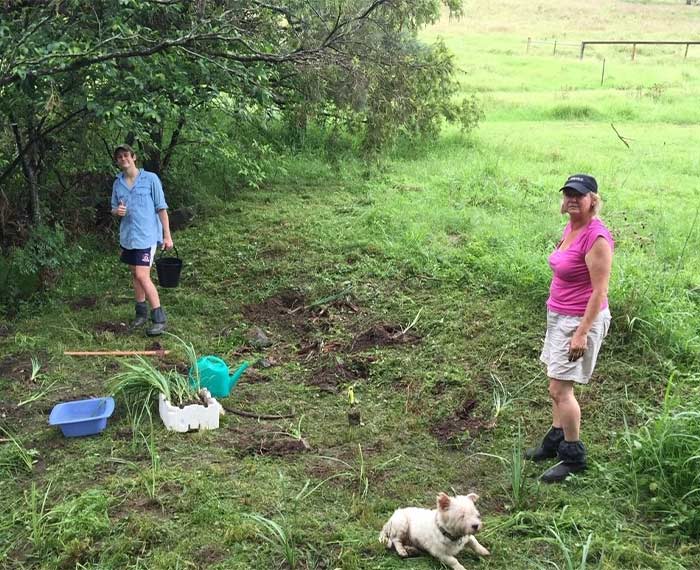Council's One Million Trees program continues to grow

The Fletcher family's first million trees planting in 2015 - Tonia and her son William with Montie the dog.
Of the 735,000 trees provided to Scenic Rim landowners as part of Council's One Million Trees program, some 4500 have been planted at the Fletcher family’s 20-hectare property at Croftby alone.
The Fletchers have been involved with the One Million Trees program since 2015, digging countless holes with crowbars and shovels to plant a range of native species including gum trees, she oaks, wattles, lomandras and black tea trees to provide food for wildlife including glossy black cockatoos, stabilise the Teviot Brook creek bank or add nitrogen to the soil.
So many trees have been planted that Tonia Fletcher, a school teacher, has lost count but she estimates around 500 have been planted each year since she signed up for the One Million Trees initiative.
"One year we planted 1000 trees on the hill," she said.
"Every Easter or long weekend we would have family and friends come to camp and everyone would get involved, but it's less so now that everyone's kids have grown up.
"There's a lot of work in planting the trees, watering them and checking on them but I really enjoy being a part of the One Million Trees."
Council's flagship environmental program, the One Million Trees initiative was established in 2012 with the goal of planting a million trees across the region by 2025.
Council provides Scenic Rim residents, rural landholders, community groups and schools with native trees to address the loss of biodiversity by encouraging sustainable land practices, waterways restoration and the overall beautification of the region.
With the aim of creating a lasting legacy by enhancing the Scenic Rim's spectacular scenery and natural environment, the One Million Trees program includes the Rural Trees Initiative, River Trees Initiative, Habitat Trees Initiative and Community Trees Initiative.
To help rural landholders facing issues of extreme weather, production pressures and land degradation on properties of one hectare or more, Council provides up to 1000 native plants and trees suited to their area.
As well as helping to address erosion and soil salinity and stability, plantings through the Rural Trees Initiative can provide windbreaks and shade for livestock.
The River Trees Initiative is open to landowners whose properties control or border waterways and provides native plants and trees to help reduce the impacts of flooding and provide habitat for native plants and animals.
The benefits of healthy waterways literally flow on to communities downstream, and ultimately Moreton Bay, through improved water quality by bolstering the stability of stream banks to reduce erosion.
Landowners who are part of Council's Habitat Protection Program by participating in Land For Wildlife, Voluntary Conservation Agreements and Nature Refuges may apply for more than 1000 native plants and trees each year to improve the environmental values of their private property through the Habitat Trees Initiative.
While providing habitat and food for wildlife, the Habitat Trees Initiative helps to create canopy cover and connect habitat corridors as well as well as preserve and regulate a property's water and soil.
Scenic Rim schools, community groups and sporting clubs are also supported by Council in their efforts to restore or enhance key areas by planting native species.
Projects that promote environmental awareness and events such as National Tree Day and Schools Tree Day are supported by the Community Trees Initiative.
Outcomes of council's One Million Trees program have included plantings for bees and butterflies, food for koalas and glossy black cockatoos, the extension of wildlife corridors and riparian areas, erosion control, and the regeneration of agricultural land with planting of paddock trees and habitat enhancement following the removal of lantana.
Mr and Mrs Fletcher's property is home to a wide range of birds and animals including channel bill cuckoos, pheasant coucals, quails, blue wrens, firetails, monitor lizards, kangaroos, native rats and eels and is in the flight path of black cockatoos which they hope to attract.
"Council has given us a lot of help in working out what we have on our property and what we should be planting," Mrs Fletcher said.
"Every time we get new neighbours we tell them to go to Council's website and look at the One Million Trees and Land for Wildlife programs and work out what they want to do.
"Everyone is surprised to learn that these programs are provided free by Council."
